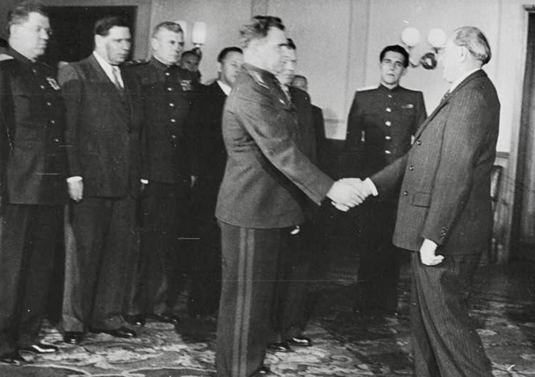City Fighting and Regrouping in a Crisis
- Maria A. Kithcart

- Sep 2, 2024
- 4 min read

Pictured: Commander Chuikov and Commissar Gurov at the 62nd Army HQ, Stalingrad; Original orders dated 25 September 1942 signed by the 62nd Army Military Council, from the Memory of the People (Pamyat Naroda) website.
In a speech given after the war (Materials of a scientific conference on the study of the Berlin operation of the troops of the 1st Belorussian Front. Babelsberg, 9-12 April 1946), Commander of the 62nd - 8th Guards Army Colonel-General V. I. Chuikov explained his use of the term “city fighting” to describe the struggle in Stalingrad:
“Well, as everyone knows, the 62nd Army or 8th Guards is, to a certain extent, the ancestor of the assault groups in the city, we used them in all urban battles. I discard the term street fighting--there are no street fights, there are city fights, because the fight in the city requires that [the street] be empty and the square too. Fights are going on in houses and backyards; through the walls of houses, through windows and doors, through gaps—this is where the path is for infantry, tanks and guns, inclusive, up to large calibers.
It is very difficult to walk along the street, especially when the houses of this street [are] busy with the enemy and when you meet with walls that can be hollowed out very hard. An assault group, comrades, is not some kind of homogeneous organization--say, a company with such and such reinforcements ... is being formed depending on the object of attack. Where you need to give a 203-mm gun, you will give it there, and where it is not needed, it will {take a} 45 mm. It all depends on the role that this assault team is supposed to fulfill, and it is formed on the move--during the battle, from the reserve, which the commander must have an assault detachment (battalion).”
During the difficult days in September of 1942, the 62nd Army was involved in both defense and counterattacking the powerful German 6th Army. In his book titled The Battle for Stalingrad, Marshal Chuikov recalled that critical period and included orders given to his troops:
“We decided to partially regroup the Army’s units during the night, in order to strengthen and consolidate […] in the area of Mamayev Kurgan. The order to regroup was issued on September 25.
MILITARY ORDER NO. 164
62nd Army H.Q. 25.9.42 23.00
1. From the Gorodishche and Alexsandrovka area, the enemy is preparing an attack in the general direction of Gorodische-Barrikady.
2. The Army will continue to hold the line it occupies and will carry on street fighting with part of its forces in order to destroy the enemy in the city.
I issue the following orders:
1. The 112th Division (Sologub’s) with two attached mortar companies and with the support of the 186th Anti-Tank Artillery Regiment will occupy and consolidate a second line of defence along Vishnevaya Gully by 04.00 on 26.9.42.
Boundary on the right—the corner of the gardens 1,000 yards west of Dizelnaya, the bridge across the Mechetka. Boundary on the left—the east side of Vishnevaya Gully as far as the railway line, and then along the railway to the outskirts of the Krasny Oktyabr settlement.
The aim will be (a) to prevent the enemy reaching the Barrikady and Krasny Oktyabr workers’ settlements, and (b) to prevent any advance by the enemy towards the Tractor workers’ settlement.
2. Three garrisons, each consisting of a platoon of tommy-gunners, will be prepared, ready to go into action in the settlements. One platoon will defend School No. 32 buildings and the stone building on Zherdevskaya Street. The second platoon will occupy the nursery buildings and shop on Kolpakovskaya Street in the Barrikady settlement. The third platoon will occupy School No. 20 buildings and the bath-house at the crossroads of Kazachya and Dublinskaya Streets. […]
3. The 284th Division (Batyuk’s) will take over the defences along the north side of Dolgi Gully from the 112th Division, and will prepare them as an anti-tank line of defence. […] Under no circumstances will the enemy be allowed to reach Artileriski Street and the bank of the Volga.
4. The 95th Division (Gorishny’s) will consolidate firm positions along the southern border of the wood (along Kolodeznaya Street) and prepare a stronghold with all around defences on the slopes of Hill 102.0. […] Under no circumstances must the enemy be allowed to take the stronghold on Hill 102.0.
5. The 13th Division (Rodimtsev’s) will continue to destroy the enemy in the centre of the city and in the vicinity of the central landing-stage.
6. All the Army’s troops will be ready by dawn on 26.9.42 to repel possible enemy attacks, particularly in the direction Gorodische-Barrikady.
This regrouping took place while in direct, close contact with the enemy, under his very nose, with a small depth in front. […] The terrain abounded in deep gullies, destroyed buildings, obstructions, bomb and shell craters. The slightest miscalculation in timing or failure to carry out proper camouflage threatened to wreck our regrouping operation and bring about heavy losses.” (150-152)



